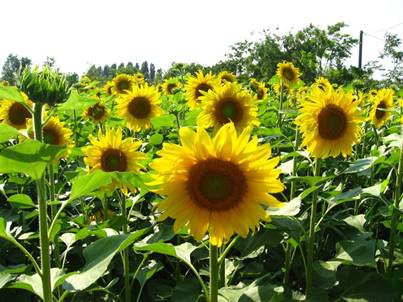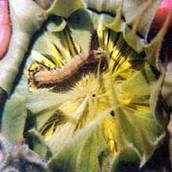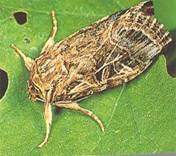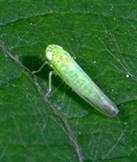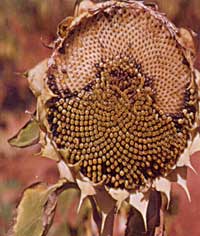Common name: Sunflower
Scientific Name: Helianthus annus
Family: Asteraceae
| 1. Capitulum borer (Head borer): Helicoverpa armigera |
Symptoms of damage
- The larva feeds on the developing seeds and bore the head.
- Fungal developed and head starts rotting.
- The larva consumes leaf in early stage of growth and move towards the capitulum and tunnel the head.
|
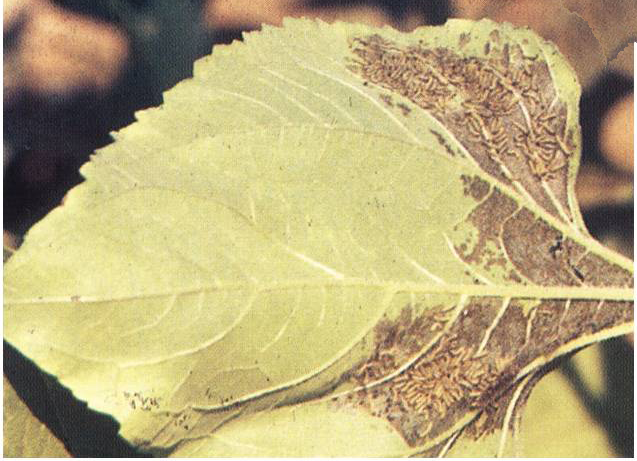 |
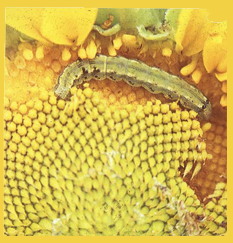 |
|
|
| |
|
Caterpillar bore into head |
|
|
Identification of the pest
- Eggs: Spherical in shape and creamy white in colour, laid singly
- Larva: Shows colour variation from greenish to brown. It has dark brown grey lines on the body with lateral white lines and also has dark and pale bands.
- Pupa: Brown in colour, occurs in soil, leaf, pod and crop debris
Adult
- Light pale brownish yellow stout moth.
- Forewings are olive green to pale brown with a dark brown circular spot in the centre.
- Hind wings are pale smoky white with a broad blackish outer margin.
|
|
Management
- Grow inter crops like, green gram, black gram, groundnut, soybean.
- Sow 3- 4 lines of maize (or) jowar around the sunflower crop to monitor the moth.
- Sow trap crops like marigold at 50 plants/acre.
- Use of pheromone traps (4 traps/acre) for pest intensity identification as well as to trap the male moths.
- Setting of light traps (1 light trap/5 acre) to know the range of pest incidence as well as to kill moth population.
- Release predators like coccinellids, Chrysoperla carnea @ 1 larva/ head.
- Release parasitoides like Trichogramma spp. @ (20,000/acre), Bracon spp., Campoletis spp.
- Spray HaNPV 250 LE + Bt @0.5kg/ha for effective control.
- Spray HaNPV 250 LE/ha + 1 kg Jaggery + 200ml Sandovit (or) Teepal; mixing and spray in the evening hours only.
- Spraying of 5% Neem oil or 5% Neem Seed Kernal extract before egg laying.
- Spray quinalphos 3m/lit of water or profenophos 2m/lit of water or chlorphyriphos 2.5m/lit of water.
|
|
| 2. Bihar hairy caterpillar: Spilosoma obliqua |
Symptoms of damage
- Young larvae feed gregariously mostly on the under surface of the leaves.
- Caterpillars feed on leaves and in severe infestation the whole crop is defoliated.
- Drying up of infected leaves is the main symptom
Identification of the pest
- Eggs: Laid in cluster on the underside of leaves.
- Larva: Covered with long yellowish to black hairs
Adult
- Medium sized brown moth with a red abdomen.
- Wings pinkish with numerous black spots.
Management
- Deep summer ploughing.
- Use of well rotten manures.
- Intercropping with pigeon pea at a row ratio of 2:1 is effective in reducing the insect attack.
- Collection and destruction of larvae.
- Spray phosalone 35 EC at 1000ml/ha.
|
|
|
| 3. Tobacco caterpillar : Spodoptera litura |
Symptoms of damage
- The larvae feed on the tender leaves, shoots, bracts and petals.
- Later, the larvae spread in the field causing defoliation.
- The larvae also feeds on the developing seeds in capitulum.
Identification of the pest
- Egg: Egg masses appear golden brown.
- Larva: Pale greenish with dark markings. Gregarious in the early stages
Adult
- Forewings: Brown colour with wavy white marking
- Hind wings: White colour with a brown patch along the margin
Management
- Hand pick the Helicoverpa larvae and destroy.
Spray any of the following insecticides :
- Dichlorvos 76EC 500 ml/ha
- Phosalone 35 EC 1000 ml/ha
Dust any one of the following :
- Phosalone 4 D 25 kg/ha
- Insecticidal application at the time of bee visit is toxic to honey
bees. So, apply the insecticides after 4 pm when the bee activity
is minimum.
- Do not spray insecticides on the same day when NAA is sprayed
|
|
| |
|
| 4. Leaf hopper (jassids): Amrasca biguttula biguttula |
Symptoms of damage
- The adult and nymphs suck the plant sap.
- The infected leaves show pale yellow colouration.
- In case of heavy infestation the leaves turn inwards.
- The leaf edges may turn light pinkish brown.
Identification of the pest
- Nymphs - Pale greenish almost translucent and walk diagonally.
- Adults - Greenish yellow, wedge shaped with a pair of black spots on vertex and a black spot on each of the forewings
|
|
Management
- Treat seed with imidacloprid 70 WS at 7 g/kg protected the sunflower plants from leaf hopper upto 7 weeks.
- Spray Imidacloprid 70% WS 490 ml/ha
- Imidacloprid 17.8%SL 100 ml/ha
|
|
| 5. Parakeet: Psittacula krameri |
Symptoms of damage
- The birds damage starts from the milky stage and continues till harvest.
- These consumes on an average of 152 seeds/day.
Identification of the pest
- It is slim, green parakeet with the typical short, heavy, deeply hooked, red bill. Hollow space in a tree trunk is the nest of the bid
Management
- Establishment of scare crows in the field so as to distract the birds.
- Bursting of crackers and carbide guns, tying polythene bags.
- Use of bird scaring tape (reflective ribbon or bird scaring ribbon).
- Using bio-acoustic method like pre-recorded distress calls to distract the birds.
- Destruction of bird nest in and around the field.
- Deploy two labourers per hectare to scare away the birds.
- Pruning of perching and breeding places
- Spraying of neem kernal powder solution at 10 g/litre of water after seed shedding repels the birds.
- Use of bird proof nets.
|
|
| Updated on Feb, 2023 |
|

